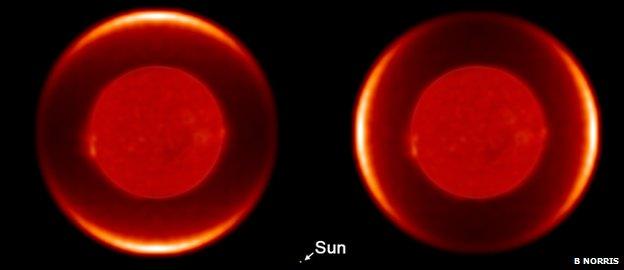Stardust recycling mystery solved
- Published

A computer model shows what the red giant W Hydrae would look like in different polarisations of light
A long-standing mystery about how dying stars spew out the material of future planets is now solved, scientists say.
While stars like our Sun are known to eject much of their mass in their final years, it has remained unclear just how the dust is blown away.
Scientists <link> <caption>reporting in Nature</caption> <url href="http://www.nature.com/nature/journal/v484/n7393/full/nature10935.html" platform="highweb"/> </link> describe an astronomical study of extraordinary resolution to tackle the mystery.
They found dust grains of nearly a millionth of a metre across, big enough to be pushed out by dying stars' light.
The team of astronomers from Australian and European universities took a look at three so-called red giant stars - stars that were once like our Sun is now, but that have exhausted their supply of hydrogen and grown to gargantuan proportions.
In a process that is an extreme case of the kind of solar wind that our own Sun experiences, such stars blow much of their mass away in the form of gas and grains of mineral material on their way to becoming white dwarfs.
Lead author of the study Barnaby Norris, of the University of Sydney, told BBC News that the stars were "the galaxy's great recyclers" - the material that they spit out "goes on to make the next generation of stars and planets".
Polarising discussion
What has confused astronomers until now is just how that material is expelled; computer models of the process suggest that particles coming from the stars should be so small that they would simply absorb the light around them and undergo significant heating.

The measurements were made with the European Southern Observatory's VLT
To get a look at the dust surrounding the three red giants, Mr Norris and his colleagues used the Very Large Telescope in Chile, applying a technique called polarimetric interferometry.
The light from the three stars, like that from our Sun, is unpolarised - the light waves undulate in random directions.
But light that strikes the dust surrounding them is preferentially bounced toward us, undulating along a particular direction - just as sunlight reflected off a body of water is polarised along a direction parallel to the water's surface.
The team refined a method of blocking some of the VLT's light and combining images of the stars in different polarisations. As a result, they could tell apart distant objects separated by just 15 billionths of a degree in the sky.
"This is equivalent to standing in Sydney and looking at a coffee cup sitting on a desk in Melbourne, and being able to measure its size," Mr Norris explained.
The team saw that the sphere of dust surrounding the red dwarfs was smaller than many models suggest - within two times the radius of the star itself.
Because grains of dust scatter the light differently depending on the colour of the light that hits them, the team was able to analyse their data for different colours and determine an average grain size: not much more than half a millionth of a metre.
That is far larger than anticipated, and as Mr Norris explained, large enough to solve the mystery of how the dust gets expelled: "The dust grains are like lots of little sails catching the wind, or in this case, starlight."
"The mechanism by which mass is transported away from these stars is one of the biggest questions in stellar astronomy, and underpins our whole understanding of how heavy elements are spread throughout the galaxy. Our study is just one small piece in this puzzle."
- Published28 October 2011
- Published1 September 2010